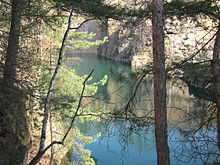Koenigshain Mountains
The Königshain Mountains ( Upper Sorbian Limas ) are located in Eastern Upper Lusatia west of the city of Görlitz in the district of Görlitz . They are located north and south of the eponymous municipality of Königshain and are an extensive, approximately 50 km 2 large and mostly wooded granite area . The highest elevations are 415 m above sea level. NHN high fighter mountains and the famous Hochstein with 406 m above sea level. NHN . The entire Königshain Mountains have been a landscape protection area since 1974 . In a part (Elysium) of the former ridge quarry there is a bird sanctuary.
description
The free-standing granite rocks that still exist today are the remains of over 100 free-standing rock towers up to 24 m high, which were removed during the more than 200-year quarry activity. The Königshain granite was used as a building material for the Reichstag building in Berlin and the lighthouse on Cape Arkona . As early as 1842, the pavement around what was then the Royal Palace of Berlin was made from this stone. The bank protection wall of the island of Helgoland is also made of this material. After 1945 they built S-Bahn stations in Berlin ( Alexanderplatz ), the Berlin Dynamo Stadium , the Fichtelberg Hotel and parts of the Soviet memorial in Berlin-Treptow . Today the granite mining museum and numerous quarry holes and lakes testify to the earlier mining. On the Hochstein there are some remaining free-standing rock towers next to an observation tower and the mountain hut . The area around the Hochstein has been a nature reserve since 1930. In 1975 the quarry was finally closed. The free-standing rocks and the walls of the former quarries have been used for climbing since the 1970s.
The northern part of the Königshainer Berge crosses under the federal highway 4 with the tunnel Königshainer Berge , the third longest highway tunnel in Germany.
Dead stone
The best-known still existing rock group is the approximately ten meter high Totenstein . The rock served as a cult site in prehistory and early history and has been known as a find site since the 17th century. Numerous testimonies were found here by Carl Adolph Gottlob von Schachmann . The oldest finds (including ceramic shards, bronze jewelry remains, arrowheads) date from the Middle Bronze Age and the Early Iron Age and are therefore over 3000 years old. In addition, numerous high and late medieval pottery shards were recovered. Due to the great research interest in the Totenstein , it was placed under protection by the Prussian King Friedrich Wilhelm IV during a visit in 1844 as a " monument of prehistoric times ".
Firestone
The Firstenstein, also called Scheffel or Mittagsstein, was the highest of the free-standing rocks in the Königshain Mountains. It was declared a natural monument in 1920. A granite column was erected on the rock. Nevertheless, it fell victim to quarrying in the 1930s. At the summit there was a memorial column in honor of the landowner and pioneer of the Upper Lusatian Society of Sciences in Görlitz , Carl Adolph Gottlob von Schachmann (1725–1789). This had done a lot for the development of the area. The column also had to give way to the ongoing dismantling. Today the three-part Firstensteinbruch is located here below the Firstensteinkuppe (380.2 m). This is also called the clay hole because of the high proportion of clay in the rock. The water depth is up to 15 meters.
Cuckoo stone
The cuckoo stone is a small, bird's head-like rock with an artificial viewing hole as an eye. During the winter solstice , the midday sun appears in it for several days.
The sacrificial stones
The sacrificial stones lie between the small town of Biesig and the Eichberg (338 m). The first sacrificial stone is two meters wide, one meter high and rectangular. A smaller stone not far from him is the reason for the name pronounced in the plural. Both are listed as cultural and sacrificial acts took place on them in Slavic times.
Climbing sport
The first verifiable climbs took place in the early 1950s on the Totenstein and the Teufelssteinen by Görlitz climbers. In the 1970s, some training routes for artificial climbing were created in Hamannbruch. The main wave of development began in the mid-1980s, in which not only local climbers but also well-known climbers from Saxon Switzerland such as Bernd Arnold took part. In the 1990s, the difficulties with the Silesian Way reached the eleventh degree ( UIAA ). The development can now be regarded as almost complete. There are currently eight peaks and ten massifs (quarry walls) with over two hundred paths to climb.
literature
- Görlitz and its surroundings (= values of the German homeland . Volume 54). 1st edition. Verlag Hermann Böhlaus successor, Weimar 1994, ISBN 3-7400-0932-2 .
- Thomas Giesler: The rocks Eulenstein, Zeisigstein and Teufelsstein - search for traces in the Königshain mountains. in: Reports of the natural research society of Upper Lusatia. Volume 24, Görlitz 2016, pp. 69–82 ( digitized version )
- Thomas Thränert: The rulership as a space for knowledge and design - Carl Adolph Gottlob von Schachmann and his Gut Königshain . In: The garden art . Volume 30, No. 1 , 2018, p. 63-74 .
Web links
Coordinates: 51 ° 11 ′ 40 ″ N , 14 ° 50 ′ 20 ″ E








